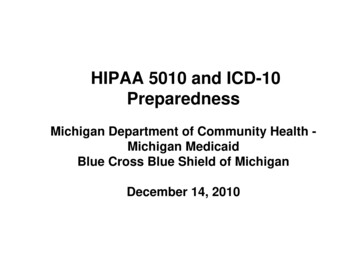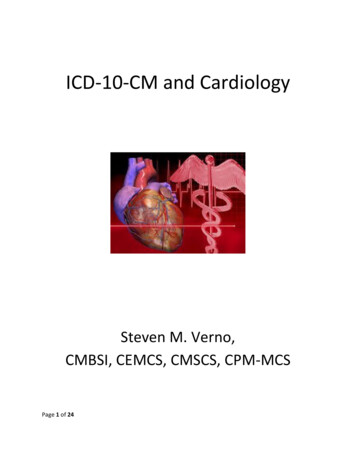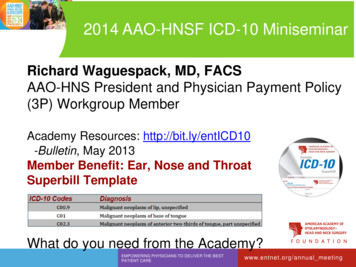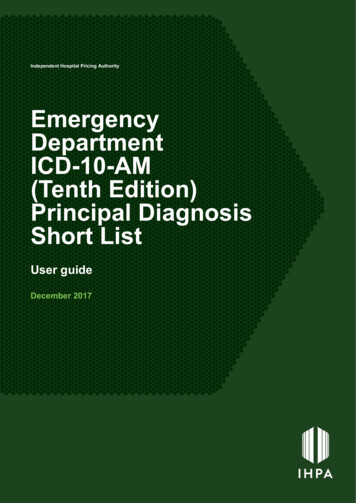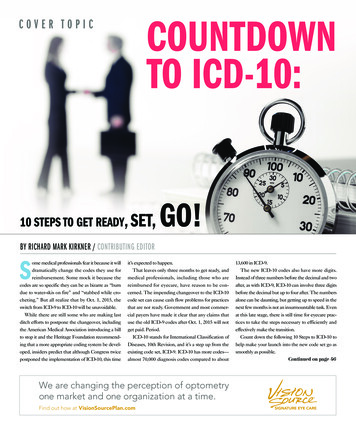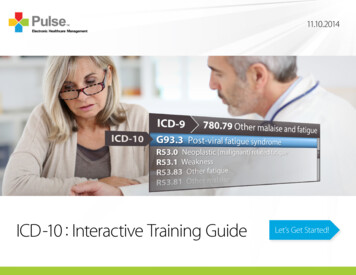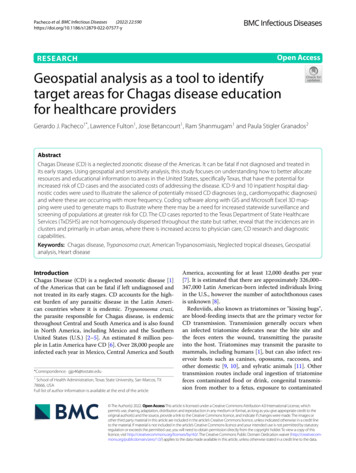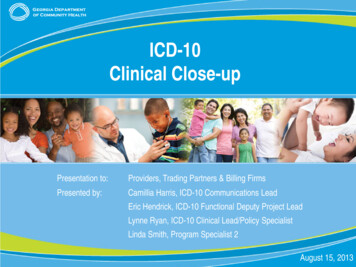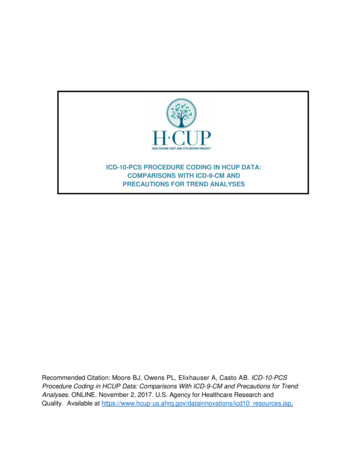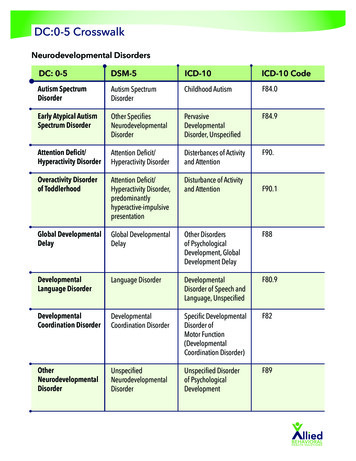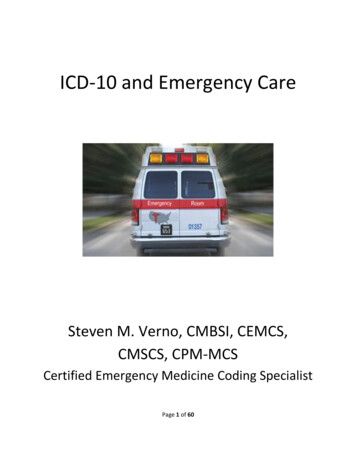
Transcription
ICD-10 and Emergency CareSteven M. Verno, CMBSI, CEMCS,CMSCS, CPM-MCSCertified Emergency Medicine Coding SpecialistPage 1 of 60
ICD-10 and Emergency CareSteven M. Verno, CEMCSNote: ICD-9-CM and ICD-10 are owned and copyrighted by the WorldHealth Organization. The codes in this guide were obtained from the USDepartment of Health and Human Services, NCHS website. This guide does not contain ANY legal advice. This guide shows what specific codes will change to when ICD-9-CMbecomes ICD-10-CM. This guide does NOT discuss ICD-10-PCS. This guide does NOT replace ICD-10-CM coding manuals. This guide simply shows a practice what ICD-10-CM will look likewithin their specialty. The intent is to show that ICD-10 is not scaryand it is not complicated. This guide is NOT the final answer to coding issues experienced in amedical practice. This guide does NOT replace proper coding training required by amedical coder and a medical practice. Images or graphics wereobtained from free public domain internet websites and may holdcopyright privileges by the owner.This guide was prepared for Free.If you paid for this, demand the return of your money!If the name of the original author, Steve Verno, has beenreplaced, it is possible that you have a thief on your hands.Page 2 of 60
For the past thirty-one (31) years, we have learned and used ICD-9-CM when diagnosiscoding for our providers. ICD stands for International Classification of Diseases. We’vebeen using the 9th Revision to code a documented medical condition. We will bereplacing the 9th Revision with the 10th revision. As someone once said, just when welearned the answers, they changed the questions. Also, for years, there has been rumorthat ICD-10 would be replacing ICD-9, and now this will soon be a reality.ICD-10 will replace ICD-9-CM as of October 1, 2014.There is a new rumor that ICD-10 will be bypassed with ICD-11. The problem with thisnew rumor is that there is nothing, in writing, about this rumor. The fact that ICD-10will be effective as of October 1, 2014 is published by the Centers for Medicare andMedicaid Services and the World Health Organization. Anytime someone tells yousomething, GET IT IN WRITING! Rumors can ruin a practice and can cost a practice alot of money because you trust the person who told you the rumor and you want tobelieve it, so you or you have your staff search the Internet for anything that providesprovenance to the rumor. That is a huge waste of time and money and the persondoing the searching may never find an answer.In coding, there is a rule, “If it isn’t documented, it doesn’t exist”. If an employee or adoctor told you something, make sure that they provide you with documentation toback it up. I am a speaker at conferences. Anything I present has laws, rules, orpolicies provided to show that what I’m saying is true, accurate, and correct. Ifsomeone says something, and you ask to see their proof, in writing, and they don’thave it, case closed. You stop the rumor immediately and you save time and money inwasteful time researching.Almost every day I see, “I need to find an answer to an office bet” and then thequestion comes up. “We have one employee that says and another employee says Who is right and please provide me with any and all references to back up yourresponse, and, please, no jokes or funny responses please be serious.” Thesequestions are being discouraged and not answered.In this guidebook, I reference guidelines and the official website where you candownload it, for free. I personally attended a conference where I heard a speaker saysomething that didn’t sound right. I wasn’t the only one because many hands went up.The speaker had many respected certifications, yet failed to provide any proof to theirPage 3 of 60
statement. When I asked the speaker for their documentation, he smiled and said “I’llsend it to you.” He walked away; never asking me for my address so that he couldprovide me with his answers and references. His walking away told me that he wasn’tgoing to send it. It’s been at least 10 years and nothing has come forth from thisspeaker. All this did was lower my respect for this person and I now questioneverything this person provides. I refuse to attend any conference where he stillspeaks.Some people will spend hours on the internet trying to find out if what someone said istrue. Coding and Billing are open to many rumors. For years, people have said, “Iheard that ICD-9 is being replaced by ICD-10 this year, can someone tell me if this istrue?” Or someone would say, “This year, ICD-10 replaces ICD-9.” The problem is thatthese rumors weren’t true, but, someone, tried to look important by saying it washappening. Right now a rumor going around is that ICD-10 won’t take effect, and ICD10 will be bypassed and we will go straight to ICD-11. That rumor has nothing to proveit is true. Nothing has been published by CMS, published in the Federal Register,documented at the Centers for Disease Control or World Health Organization. ICD-10will become effective on October 1, 2014, it is true. Proof of ICD-10 being effective onOctober 1, 2014, can be found here at the CMS website and Federal /FR-2012-09-05/pdf/2012-21238.pdfNow October 1, 2014 is on a Wednesday. What this means is, on Tuesday, September30, 2014, you will use ICD-9-CM. At the end of the day, put your ICD-9 manuals in asafe place because you may need them later on and I will explain this. When you comein the next morning, you will open the brand new ICD-10-CM manuals and code thevisit using them.One huge change with ICD-10-CM is that there will be more codes to select from. ICD9 has about 14,000 codes. ICD-10 starts with 68,000 codes and can go higher. ICD-9did not have a code for a cranialrectal blockage, so you couldn’t code that diagnosis orPage 4 of 60
you had to select an unspecified code, but now you can have a code for a cranialrectalblockage (YOU do know that cranialrectal blockage is not a real disease or injury).ICD-10 is going to change the way YOU do business. Why? It is 100% dependent onmedical record documentation. ICD-9 was forgiving to a doctor who is lax on theirdocumentation. Steve could visit Dr. Smith with pain in his right ear. All Dr. Smith hadto document was that Steve has OM which is short for otitis media and the coder couldselect a code for simple OM.That code is 382.9 - Unspecified otitis media, Otitis media: NOS, acute NOS, chronicNOSICD-10 will require more work on the provider to document the exact type ofdiagnosis found with the patient. ICD-10 demands documentation of theanatomical area affected and allows for coding of chronic modalities.Under ICD-10-CM, you have the following codes for Otitis Media:H66.9 Otitis media, unspecifiedH66.90 Otitis media, unspecified, unspecified earH66.91 Otitis media, unspecified, right earH66.92 Otitis media, unspecified, left earH66.93 Otitis media, unspecified, bilateralAs you can see, under ICD-9-CM, you have one code you can select if thedocumentation is not specific. The patient may have been a child with ear pain in bothears, but all the doctor wrote is “OM” and nothing more.Under ICD-10-CM, you have a possibility of five (5) codes and you do need moreanatomical information to select the best possible code. Using a pure unspecified codesuch as H66.9 could cause your claim to be pended or placed under review, whichcould cause a significant revenue loss for the practice. A favorite doctor that I’veknown for many years is an expert witness where he is called to determine if amalpractice lawsuit should proceed to court or if the malpractice insurance companyshould issue a check. In most cases, after looking at the medical record, herecommends writing a check. He provides instruction to medical interns and residentsPage 5 of 60
and he tells them: “Document the visit as if you had to appear in court to defend youractions. “ I usually add, “Document the visit as if your paycheck and career is on theline.”I spend a lot of my time returning medical records for additional information becausethe documentation is insufficient to code the visit with 100% truth, accuracy andcorrectness. I code to protect the doctor, the patient, and MY paycheck. I only codewhat is documented. I never code a visit just to get paid. There will be an unofficial rulewith coding and that rule will be: If it isn’t documented, we don’t code it. We do NOTcode something just to get it paid.With 30 years of clinical medicine in my personal background, I can say I know whatshould have been done during the visit, but I can’t code based on that. I’ve seendoctors tell me, “I did this procedure.” I say show me where it says you did this.There is no documentation to prove that the doctor said they did what they say and thedoctor loses.I also NEVER code based on what I am told on the Internet. I don’t know if what I’mtold is 100% true, accurate and complete. I don’t know if the person asking thequestion works for a doctor or if they are a coding student and I NEVER help students.If I provide them with answers, they submit my work as their own and that is academicfraud. I NEVER support fraud, including academic fraud, in any form. If I do a coderswork for them, they will never learn to become self-sufficient. If they go to work for adoctor, their lack of how to code could cost the doctor revenue or open doors to audits,inspections and refund demands. They could go so far as to Internet code. Internetcoding is going to a website like ask yahoo or a coding and billing forum to ask whatcode should be used. Let’s say you have an untrained coder who needs to code acranialrectalectomy. They will go to the Internet and ask, “I forgot what the code is fora cranialrectalectomy. Can someone help me?” When they don’t get a response, theybecome angry and then they will post, “Can’t anyone here help me out? I thought Icould get someone to help me here!” Thinking that posing a guilt trip will do the work,but it won’t.We have a generation that wants others to do their work for them and by putting aguilt trip on someone, they get instant gratification, but they don’t know if what wasprovided is correct. Someone may come along with a name of ToddCPC and say weuse code 99999. The name ToddCPC makes you believe that they are a certified coderbecause CPC stands for Certified Professional Coder. ToddCPC is NOT a coder.Page 6 of 60
ToddCPC is a 15 year old school kid in Omaha, Nebraska or a 19 year old hacker inRussia, having fun pranking the poster.So, now the coder enters 99999 as the code and sends the claim to the insurancecompany. The claim is denied payment. Claim after claim is denied payment becausethis coder is sending claims with bad codes. The doctor begins to notice the volume ofdenials and notices a huge drop in his practice revenue, so he contacts a consultant.In addition, the insurance company put a halt on all claims sent by the doctor. Theysend a letter demanding medical records and they’re now going back 20 years. Theinformation on the claim is wrong and it is not documented in the medical record. Thenext letter the doctor receives is a demand for the return of claim payments and theyare demanding a 6 figure refund. The doctor can’t fight this because the claim wassent with wrong codes, codes that are not supported by the medical recorddocumentation.I recently went to a doctor who received a letter demanding the return of 64,000.That would cause him to go out of business. I showed how his coder was sendingclaim with wrong codes and that the medical record documentation was so poor, thatthey didn’t support any correct code that was submitted.Again, DOCUMENT THE MEDICAL RECORD AS IF YOU HAD TO GO TO COURT!Coding GuidelinesMany of the guidelines under ICD-9-CM won’t change under ICD-10-CM. Youwill see new guidelines because ICD-10 will offer new codes never seenbefore. As an example:ICD-9 Guideline for Symptoms:Signs and symptomsCodes that describe symptoms and signs, as opposed to diagnoses, are acceptable forreporting purposes when a related definitive diagnosis has not been established(confirmed) by the physician. Chapter 16 of ICD-9-CM, Symptoms, Signs, and Illdefined conditions (codes 780.0 -799.9) contain many, but not all codes for symptoms.Page 7 of 60
7. Conditions that are an integral part of a disease processSigns and symptoms that are integral to the disease process should not be assigned asadditional codes.8. Conditions that are not an integral part of a disease processAdditional signs and symptoms that may not be associated routinely with a diseaseprocess should be coded when present.ICD-10 Guideline for Symptoms:Signs and symptomsCodes that describe symptoms and signs, as opposed to diagnoses, are acceptable forreporting purposes when a related definitive diagnosis has not been established(confirmed) by the provider. Chapter 18 of ICD-10-CM, Symptoms, Signs, and AbnormalClinical and Laboratory Findings, Not Elsewhere Classified (codes R00.0 - R99) containsmany, but not all codes for symptoms.5. Conditions that are an integral part of a disease processSigns and symptoms that are associated routinely with a disease process should not beassigned as additional codes, unless otherwise instructed by the classification.6. Conditions that are not an integral part of a disease processAdditional signs and symptoms that may not be associated routinely with a diseaseprocess should be coded when present.As you can see, both guidelines are virtually identical, so the change to ICD10 won’t be a shock to a trained coder.Page 8 of 60
Emergency Coding GuidelinesThe guidelines listed below came from the ICD-10-CM Coding guidelines which camefrom the Centers for Disease Control website located athttp://www.cdc.gov/nchs/data/icd/icd10cm guidelines 2014.pdfLate Effects (Sequela)A late effect is the residual effect (condition produced) after the acute phase of an illness orinjury has terminated. There is no time limit on when a late effect code can be used. Theresidual may be apparent early, such as in cerebral infarction, or it may occur months or yearslater, such as that due to a previous injury. Coding of late effects generally requires two codessequenced in the following order: The condition or nature of the late effect is sequenced first.The late effect code is sequenced second.An exception to the above guidelines are those instances where the code for late effect isfollowed by a manifestation code identified in the Tabular List and title, or the late effect codehas been expanded (at the fourth, fifth or sixth character levels) to include the manifestation(s).The code for the acute phase of an illness or injury that led to the late effect is never used witha code for the late effect.Reporting Same Diagnosis Code More than OnceEach unique ICD-10-CM diagnosis code may be reported only once for an encounter. Thisapplies to bilateral conditions when there are no distinct codes identifying laterality or twodifferent conditions classified to the same ICD-10-CM diagnosis code.SepsisFor a diagnosis of sepsis, assign the appropriate code for the underlying systemic infection. Ifthe type of infection or causal organism is not further specified, assign code A41.9, Sepsis,unspecified.A code from subcategory R65.2, Severe sepsis, should not be assigned unless severe sepsis oran associated acute organ dysfunction is documented.(i) Negative or inconclusive blood cultures and sepsisNegative or inconclusive blood cultures do not preclude a diagnosis of sepsis in patients withclinical evidence of the condition, however, the provider should be queried.(ii) UrosepsisThe term urosepsis is a nonspecific term. It is not to be considered synonymous with sepsis. Ithas no default code in the Alphabetic Index. Should a provider use this term, he/she must bequeried for clarification.Page 9 of 60
(iii) Sepsis with organ dysfunctionIf a patient has sepsis and associated acute organ dysfunction or multiple organ dysfunction(MOD), follow the instructions for coding severe sepsis.Septic shockSeptic shock is circulatory failure associated with severe sepsis, and therefore, it represents atype of acute organ dysfunction. For all cases of septic shock, the code for the underlyingsystemic infection should be sequenced first, followed by code R65.21, Severe sepsis withseptic shock. Any additional codes for the other acute organ dysfunctions should also beassigned.Septic shock indicates the presence of severe sepsis. Code R65.21, Severe sepsis with septicshock, must be assigned if septic shock is documented in the medical record, even if the termsevere sepsis is not documented.Diabetes mellitusThe diabetes mellitus codes are combination codes that include the type of DM, the bodysystem affected, and the complications affecting that body system. As many codes within aparticular category as are necessary to describe all of the complications of the disease may beused. They should be sequenced based on the reason for a particular encounter. Assign asmany codes from categories E08 – E13 as needed to identify all of the associated conditionsthat the patient has.Type of diabetesThe age of a patient is not the sole determining factor, though most type 1 diabetics developthe condition before reaching puberty. For this reason type 1 diabetes mellitus is also referredto as juvenile diabetes.Type of diabetes mellitus not documentedIf the type of diabetes mellitus is not documented in the medical record the default is E11.-,Type 2 diabetes mellitus.Diabetes mellitus and the use of insulinIf the documentation in a medical record does not indicate the type of diabetes but doesindicate that the patient uses insulin, code E11, Type 2 diabetes mellitus, should be assigned fortype 2 patients who routinely use insulin, code Z79.4, Long-term (current) use of insulin, shouldalso be assigned to indicate that the patient uses insulin. Code Z79.4 should not be assigned ifinsulin is given temporarily to bring a type 2 patient’s blood sugar under control during anencounter.Page 10 of 60
Secondary Diabetes MellitusCodes under category E08, Diabetes mellitus due to underlying condition, and E09, Drug orchemical induced diabetes mellitus, identify complications/manifestations associated withsecondary diabetes mellitus. Secondary diabetes is always caused by another condition orevent (e.g., cystic fibrosis, malignant neoplasm of pancreas, pancreatectomy, adverse effect ofdrug, or poisoning).Secondary diabetes mellitus and the use of insulinFor patients who routinely use insulin, code Z79.4, Long-term (current) use of insulin, shouldalso be assigned. Code Z79.4 should not be assigned if insulin is given temporarily to bring apatient’s blood sugar under control during an encounter.Assigning and sequencing secondary diabetes codes and its causesThe sequencing of the secondary diabetes codes in relationship to codes for the cause of thediabetes is based on the tabular instructions for categories E08 and E09. For example, forcategory E08, Diabetes mellitus due to underlying condition, code first the underlyingcondition; for category E09, Drug or chemical induced diabetes mellitus, code first the drug orchemical (T36-T65).Secondary diabetes mellitus due to pancreatectomyFor postpancreatectomy diabetes mellitus (lack of insulin due to the surgical removal of all orpart of the pancreas), assign code E89.1, Postsurgical hypoinsulinemia. Assign a code fromcategory E08 and code Z79.4, Other acquired absence of organ, as additional codes.Secondary diabetes due to drugsSecondary diabetes may be caused by an adverse effect of correctly administered medications,poisoning or late effect of poisoning.Chapter 5: Mental and behavioral disorders (F01 – F99)Pain disorders related to psychological factorsAssign code F45.41, for pain that is exclusively psychological. Code F45.41, Pain disorder withrelated psychological factors, should be used following the appropriate code from categoryG89, Pain, not elsewhere classified, if there is documentation of a psychological component fora patient with acute or chronic pain.Page 11 of 60
Pain - Category G89General coding informationCodes in category G89, Pain, not elsewhere classified, may be used in conjunction with codesfrom other categories and chapters to provide more detail about acute or chronic pain andneoplasm-related pain, unless otherwise indicated below.If the pain is not specified as acute or chronic, post-thoracotomy, postprocedural, or neoplasmrelated, do not assign codes from category G89.A code from category G89 should not be assigned if the underlying (definitive) diagnosis isknown, unless the reason for the encounter is pain control/ management and not managementof the underlying condition.When an admission or encounter is for a procedure aimed at treating the underlying condition(e.g., spinal fusion, kyphoplasty), a code for the underlying condition (e.g., vertebral fracture,spinal stenosis) should be assigned as the principal diagnosis. No code from category G89should be assigned.Category G89 Codes as Principal or First-Listed DiagnosisCategory G89 codes are acceptable as principal diagnosis or the first-listed code:When pain control or pain management is the reason for the admission/encounter (e.g., apatient with displaced intervertebral disc, nerve impingement and severe back pain presentsfor injection of steroid into the spinal canal). The underlying cause of the pain should bereported as an additional diagnosis, if known.When a patient is admitted for the insertion of a neurostimulator for pain control, assign theappropriate pain code as the principal or first listed diagnosis. When an admission or encounteris for a procedure aimed at treating the underlying condition and a neurostimulator is insertedfor pain control during the same admission/encounter, a code for the underlying conditionshould be assigned as the principal diagnosis and the appropriate pain code should be assignedas a secondary diagnosis.Use of Category G89 Codes in Conjunction with Site Specific Pain CodesAssigning Category G89 and Site-Specific Pain CodesCodes from category G89 may be used in conjunction with codes that identify the site of pain(including codes from chapter 18) if the category G89 code provides additional information. Forexample, if the code describes the site of the pain, but does not fully describe whether the painis acute or chronic, then both codes should be assigned.Page 12 of 60
Sequencing of Category G89 Codes with Site-Specific Pain CodesThe sequencing of category G89 codes with site-specific pain codes (including chapter 18codes), is dependent on the circumstances of the encounter/admission as follows:If the encounter is for pain control or pain management, assign the code from category G89followed by the code identifying the specific site of pain (e.g., encounter for pain managementfor acute neck pain from trauma is assigned code G89.11, Acute pain due to trauma, followedby code M54.2, Cervicalgia, to identify the site of pain).If the encounter is for any other reason except pain control or pain management, and a relateddefinitive diagnosis has not been established (confirmed) by the provider, assign the code forthe specific site of pain first, followed by the appropriate code from category G89.Postoperative PainThe provider’s documentation should be used to guide the coding of postoperative pain, as wellas Section III. Reporting Additional Diagnoses and Section IV. Diagnostic Coding and Reporting inthe Outpatient Setting.The default for post-thoracotomy and other postoperative pain not specified as acute orchronic is the code for the acute form.Routine or expected postoperative pain immediately after surgery should not be coded.Postoperative pain not associated with specific postoperative complicationPostoperative pain not associated with a specific postoperative complication is assigned to theappropriate postoperative pain code in category G89.Postoperative pain associated with specific postoperative complicationPostoperative pain associated with a specific postoperative complication (such as painful wiresutures) is assigned to the appropriate code(s) found in Chapter 19, Injury, poisoning, andcertain other consequences of external causes. If appropriate, use additional code(s) fromcategory G89 to identify acute or chronic pain (G89.18 or G89.28).Chronic painChronic pain is classified to subcategory G89.2. There is no time frame defining when painbecomes chronic pain. The provider’s documentation should be used to guide use of thesecodes.Chronic pain syndromeCentral pain syndrome (G89.0) and chronic pain syndrome (G89.4) are different than the term“chronic pain,” and therefore codes should only be used when the provider has specificallydocumented this condition.Diseases of Eye and Adnexa (H00-H59)Reserved for future guideline expansionPage 13 of 60
Chapter 8: Diseases of Ear and Mastoid Process (H60-H95)Reserved for future guideline expansionHypertensionHypertension with Heart DiseaseHeart conditions classified to I50.- or I51.4-I51.9, are assigned to, a code from category I11,Hypertensive heart disease, when a causal relationship is stated (due to hypertension) orimplied (hypertensive). Use an additional code from category I50, Heart failure, to identify thetype of heart failure in those patients with heart failure.The same heart conditions (I50.-, I51.4-I51.9) with hypertension, but without a stated causalrelationship, are coded separately. Sequence according to the circumstances of theadmission/encounter.Hypertensive Cerebrovascular DiseaseFor hypertensive cerebrovascular disease, first assign the appropriate code from categories I60I69, followed by the appropriate hypertension code.Hypertensive RetinopathyCode H35.0, Hypertensive retinopathy, should be used with code I10, Essential (primary)hypertension, to include the systemic hypertension. The sequencing is based on the reason forthe encounter.Hypertension, SecondarySecondary hypertension is due to an underlying condition. Two codes are required: one toidentify the underlying etiology and one from category I15 to identify the hypertension.Sequencing of codes is determined by the reason for admission/encounter.Hypertension, TransientAssign code R03.0, Elevated blood pressure reading without diagnosis of hypertension, unlesspatient has an established diagnosis of hypertension. Assign code O13.-, Gestational[pregnancy-induced] hypertension without significant proteinuria, or O14.-, Gestational[pregnancy-induced] hypertension with significant proteinuria, for transient hypertension ofpregnancy.Hypertension, ControlledThis diagnostic statement usually refers to an existing state of hypertension under control bytherapy. Assign code I10.Page 14 of 60
Hypertension, UncontrolledUncontrolled hypertension may refer to untreated hypertension or hypertension notresponding to current therapeutic regimen. In either case, assign code I10.Atherosclerotic coronary artery disease and anginaICD-10-CM has combination codes for atherosclerotic heart disease with angina pectoris. Thesubcategories for these codes are I25.11, Atherosclerotic heart disease of native coronaryartery with angina pectoris and I25.7, Atherosclerosis of coronary artery bypass graft(s) andcoronary artery of transplanted heart with angina pectoris.When using one of these combination codes it is not necessary to use an additional code forangina pectoris. A causal relationship can be assumed in a patient with both atherosclerosis andangina pectoris, unless the documentation indicates the angina is due to something other thanthe atherosclerosis.If a patient with coronary artery disease is admitted due to an acute myocardial infarction(AMI), the AMI should be sequenced before the coronary artery disease.Intraoperative and Postprocedural cerebrovascular accidentMedical record documentation should clearly specify the cause- and-effect relationshipbetween the medical intervention and the cerebrovascular accident in order to assign a codefor intraoperative or postprocedural cerebrovascular accident.Proper code assignment depends on whether it was an infarction or hemorrhage and whetherit occurred intraoperatively or postoperatively. If it was a cerebral hemorrhage, codeassignment depends on the type of procedure performed.Sequelae of Cerebrovascular DiseaseCategory I69, Sequelae of Cerebrovascular diseaseCategory I69 is used to indicate conditions classifiable to categories I60-I67 as the causes of lateeffects (neurologic deficits), themselves classified elsewhere. These “late effects” includeneurologic deficits that persist after initial onset of conditions classifiable to categories I60-I67.The neurologic deficits caused by cerebrovascular disease may be present from the onset ormay arise at any time after the onset of the condition classifiable to categories I60-I67.Codes from category I69 with codes from I60-I67Codes from category I69 may be assigned on a health care record with codes from I60-I67, ifthe patient has a current cerebrovascular accident (CVA) and deficits from an old CVA.Page 15 of 60
Code Z86.73Assign code Z86.73, Personal history of transient ischemic attack (TIA), and cerebral infarctionwithout residual deficits (and not a code from category I69) as an additional code for history ofcerebrovascular disease when no neurologic deficits are present.Acute myocardial infarction (AMI)ST elevation myocardial infarction (STEMI) and non ST elevation myocardial infarction(NSTEMI)The ICD-10-CM codes for acute myocardial infarction (AMI) identify the site, such asanterolateral wall or true posterior wall. Subcategories I21.0-I21.2 and code I21.4 are used forST elev
ICD-10 will replace ICD-9-CM as of October 1, 2014. There is a new rumor that ICD-10 will be bypassed with ICD-11. The problem with this new rumor is that there is nothing, in writing, about this rumor. The fact that ICD-10 will be effective as of October 1, 2014 is published by the Centers for Medicare and

